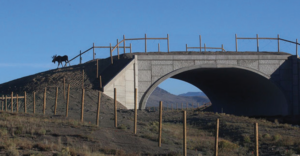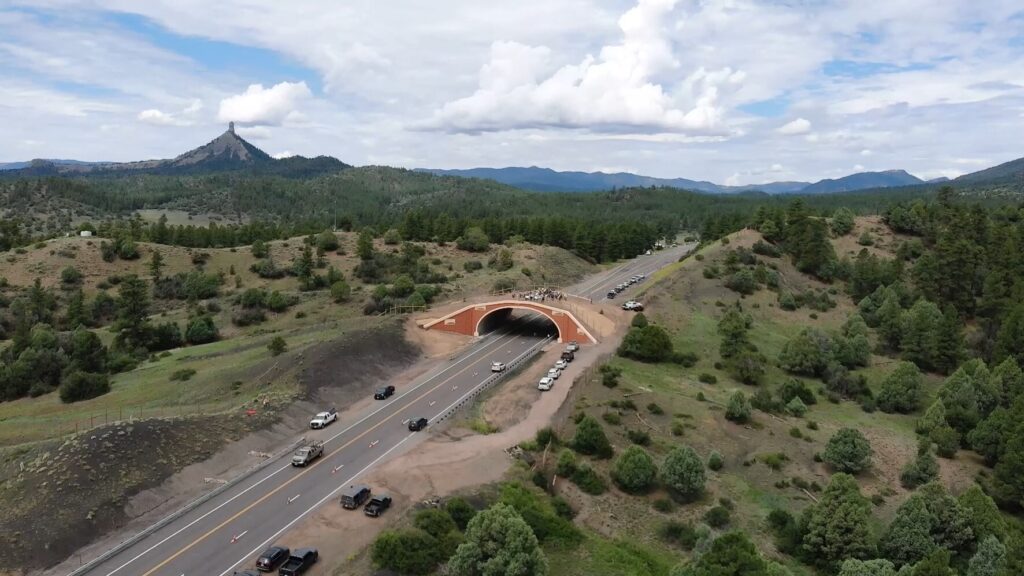A coalition of nonprofit organizations has launched a website with information and free resources for interested applicants
NEWS RELEASE
April 4, 2023

Bozeman, MT – Millions of collisions occur between drivers and animals on U.S. roads annually. To address this dangerous, expensive, and growing problem, Congress created a national Wildlife Crossings Pilot Program. This new grant program will prevent accidents and connect habitat by investing in measures that allow wildlife to safely cross over or under roads and fish to pass through streams beneath roads. Earlier today, U.S. Transportation Secretary Pete Buttigieg announced a Notice of Funding Opportunity for the program’s first round of competitive grants—nearly $112M for research, planning, design, and construction projects that aim to reduce wildlife-vehicle collisions and improve aquatic and terrestrial habitat connectivity.
To help potential applicants take advantage of this new federal funding, a coalition of nonprofit organizations has launched a website offering free resources for developing successful proposals. The nonprofit Center for Large Landscape Conservation (CLLC), which provides science and policy expertise on wildlife crossings, is part of a coalition providing support for interested entities. The coalition also includes Animal Road Crossings (ARC) Solutions, Native American Fish and Wildlife Society, National Parks Conservation Association, The Pew Charitable Trusts, and Wildlands Network. The coalition website features some of CLLC’s resources, such as a Toolkit for Developing Effective Projects under the Federal Wildlife Crossings Pilot Program and a co-hosted webinar series, Demystifying Wildlife Crossing Infrastructure. The coalition has assembled a variety of information related to planning effective wildlife crossing projects and relevant funding opportunities.
The new Wildlife Crossings Pilot Program will help prevent wildlife-vehicle collisions, which cause hundreds of human fatalities, thousands of human injuries, and millions of wildlife deaths in the U.S. each year, while costing U.S. taxpayers billions of dollars annually. And these costs are rising; the average expense of hitting an elk is more than $73,000, with vehicle repair costs increasing by around 70% since 2007.
“Wildlife crossings are gaining bipartisan support nationwide because they save lives, connect habitat, and can provide an exceptional return on investment,” says CLLC Director of Government Affairs Anna Wearn. “Doing nothing about this problem costs more than fixing it, given that proven solutions exist. However, until now, many states and Tribes simply haven’t had the capital to invest upfront in these measures that pay huge dividends for communities and ecosystems.
“The resources provided by this coalition website will help ensure a strong slate of applications for the new funding,” adds Wearn. “Ultimately, successful projects will demonstrate the value of making this pilot program permanent in subsequent federal transportation legislation.”

The new program, provided through the bipartisan Infrastructure Investment and Jobs Act of 2021 (IIJA), represents the first-ever dedicated federal funding for wildlife crossings. Studies show that properly designed and placed crossings can eliminate collisions with wildlife. These structures save taxpayers money by preventing costly accidents and stimulate economies by creating well-paying construction jobs, especially in rural communities where the majority of collisions occur.
Applications under the new program are due August 1, 2023. Eligible applicants include state departments of transportation, metropolitan planning organizations, local governments, regional transportation authorities, special purpose districts, public authorities with a transportation function, Tribes, and federal land management agencies. In most cases, applicants will need to provide 20% matching non-federal funds for their proposed projects, with the Federal Highway Administration covering the other 80% of costs.
The prospect of this match requirement inspired a flurry of legislation in 2022 and 2023 in states across the country to establish new dedicated wildlife crossings accounts. These bills seek to unlock federal dollars under the Wildlife Crossings Pilot Program and nearly 20 other IIJA grant programs with new or expanded eligibility for projects that improve habitat connectivity and/or reduce wildlife-vehicle collisions.
“In addition to the safety and economic benefits, wildlife crossings reconnect landscapes that have been fragmented by roads,” says CLLC Senior Conservationist Rob Ament. “These crossing structures allow species to access food and water, find mates, and successfully migrate, creating healthier, more sustainable wildlife populations.”
CLLC staff provided information to bipartisan legislators and congressional staff keen on developing the new program’s provisions. They worked with coalition members to demonstrate the proposed program’s necessity and broad appeal.
“It has been an exciting time for organizations like ours, which have been advocating for crossings for many years. We see momentum sweeping across the country for these win-win-win solutions,” says Ament.
For more information:
The coalition’s Wildlife Crossings website
Federal Highway Administration’s website
About the Center for Large Landscape Conservation
The Center for Large Landscape Conservation is the hub of a growing global movement to reverse fragmentation of the earth’s large landscapes and restore nature’s resilience to climate change. The Center works to connect natural areas, provide critical wildlife habitat and safe migration for wide-ranging animals, and protect ecological processes and systems. They accomplish this by developing science, crafting policy, and sharing expertise with partners, practitioners, and local communities around the world.
###
CONTACT: Christine Weinheimer, Communications Manager, communications@largelandscapes.org
Top photo: US-160 overpass in Colorado – CDOT/Tony Cady



